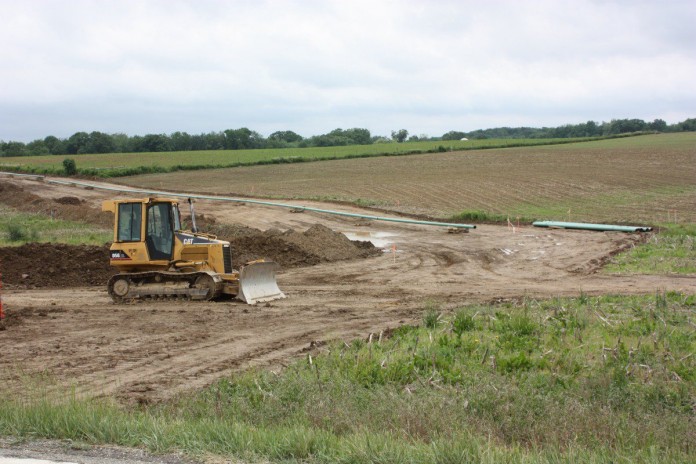SALEM, Ohio — Pipelines, pipelines, pipelines. Go almost to any public event or place in eastern Ohio and you can hear the whispers about who is getting a pipeline placed through their property or where plans call for pipelines in the future.
Shale gas production and exploration has surged in the last few years, as energy companies drill wells in the Utica and Marcellus shale formations. Natural gas is transported from the site of production to a refinery, and also to its end destination of consumption, by pipeline.
One thing is for sure, the plans supplied to the Public Utilities Commission of Ohio from the pipeline, show a maze forming in eastern Ohio.
For more shale gas news, visit the Shale Gas Reporter
And experts say approximately $130 to $210 billion will need to be spent through 2030 on midstream natural gas infrastructure in order to meet market needs.
Lines in progress
MarkWest Energy Partners has a total of 52 lines planned or in progress. They are connected to several drilling companies, including Gulfport Energy and Antero Resources and others in the southern portion of the Utica in Ohio, according to MarkWest Energy Partners.
The company is also constructing two cryogenic processing facilities; one in Harrison and one in Noble County.
Cardinal Gas Services has 50 lines planned or in the construction process throughout Ohio.
Cardinal Gas Services is involved with a project with Caiman Energy II, LLC and Dominion to form a $1.5 billion joint venture that provides Midstream services in the Utica shale.

Also in the works
There has been a rapid development of pipelines by a company called Blue Racer Midstream, which is a partnership between Dominion Gas and Caiman Energy. Blue Racer Midstream is concentrating on its western connector that will directly connect wells in Noble, Washington, Guernsey and Tuscarawas counties to the main line in West Virginia where natural gas and liquids can be processed.
The Hickory Bend Project in Mahoning County will be a $300 million investment by NiSource. It is currently under development and is expected to be gathering by the second quarter of 2013. It will be 50 miles of 20- to 24-inch gathering line, and will be the first mover of gas in northeast Ohio and western Pennsylvania.
According to PUCO, many of the lines are only approximately one mile. Others will be built 17 miles long and will cross 66 properties. The length of the lines and how many properties it crosses depends on what kind of line it is and where it is headed.
Who regulates the siting of pipelines?
The Ohio Power Siting Board certificates intrastate gas pipelines within Ohio that are greater than 500 feet in length and 9 inches in diameter and designed with a maximum allowable operating pressure of greater than 125 psi.
However, the OPSB does not have jurisdiction over production lines, gathering lines or liquid lines. Production lines are under the jurisdiction of the Ohio Department of Natural Resources. Gathering lines and liquid lines fall under local zoning jurisdiction. Interstate lines fall under the jurisdiction of the Federal Energy Regulatory Commission.
Operators are required to submit with us a pre-construction notice 21 days before any gathering pipeline is operational so OPSB inspectors can make sure they are following state and federal regulations.
Beware
Peggy Kirk Hall, director of Ohio State University Extension’s Agricultural and Resource Law Program, suggested landowners refrain from signing anything when first approached about a pipeline easement.
Hall reminded landowners that they have time, no matter what a landman tells them.
Walk the line. She encourages landowners to take the time and walk the property with the landman trying to obtain the easement.
Hall said landowners should consider who will be responsible for the upkeep of the line and if landowners will get reimbursed if the company has to come in and dig the land up again to take care of the pipeline.
She also suggested having something put in the lease for additional payment if they need to replace the pipeline with a larger size of pipe.
Hall said landowners should be able to ask for reasonable compensation for the easement, depending on the circumstances and good management of the land in the future.
Pipeline FAQ
- What is a gathering pipeline? For power siting purposes, a gathering line is any pipeline upstream from a processing facility, any line carrying gas from a processing facility to a fractionation plant and any line carrying natural gas from a processing plant to an interstate or intrastate pipeline.
- What is a liquids pipeline? For power siting purposes, liquids are defined as an individual finished product produced by a natural gas liquids fractionation plant and generally include ethane, propane, butanes and natural gasoline pipelines.
- Who regulates the siting of compressor stations, processing facilities, and fractionation plants? Compressor stations may fall under the jurisdiction of certified local building departments, where applicable. Processing facilities and liquid fractionation plants, however, are not under the jurisdiction of local building departments.
- Does the Ohio Department of Natural Resources (ODNR) have a role in siting regulation? The ODNR has jurisdiction over production operation facilities on the well head site, which includes the siting of production pipelines.













Kelly is offering good advice, not holding out the carrot of fortunes to be made.